Papers by laura rodrigues

Leprosy Review, 2004
There is clear evidence that BCG protects against leprosy, but crossimmunity with environmental m... more There is clear evidence that BCG protects against leprosy, but crossimmunity with environmental mycobacteria can interfere with vaccination protection. Some have cast doubts whether BCG vaccination can offer a significant impact against leprosy in the Brazilian Amazon, which is an endemic area for leprosy and with a high prevalence of environmental mycobacteria. This study was designed to estimate the vaccine effectiveness of neonatal BCG against leprosy in Amazon region, in Brazil. This is a cohort study nested in a randomized community trial. The study had two main results. First, neonatal BCG vaccination in Brazilian Amazon elicited protection of 74% (95% CI 57-86) against all forms of leprosy cases. Second, the highest protection was observed for multibacillary cases, 93% (95% CI 71-98). It is concluded that the study provides evidence that neonatal BCG may have an important and overlooked impact on the occurrence and transmission of leprosy, maybe even more in the future when the cohort which received a high coverage of BCG reaches the age of high incidence of leprosy.
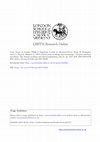
The Journal of allergy and clinical immunology, 2017
Allergic diseases are on the increase globally in parallel with a decrease in parasitic infection... more Allergic diseases are on the increase globally in parallel with a decrease in parasitic infection. The inverse association between parasitic infections and allergy at an ecological level suggests a causal association. Studies in human subjects have generated a large knowledge base on the complexity of the interrelationship between parasitic infection and allergy. There is evidence for causal links, but the data from animal models are the most compelling: despite the strong type 2 immune responses they induce, helminth infections can suppress allergy through regulatory pathways. Conversely, many helminths can cause allergic-type inflammation, including symptoms of "classical" allergic disease. From an evolutionary perspective, subjects with an effective immune response against helminths can be more susceptible to allergy. This narrative review aims to inform readers of the most relevant up-to-date evidence on the relationship between parasites and allergy. Experiments in an...
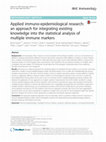
BMC immunology, May 20, 2016
Immunologists often measure several correlated immunological markers, such as concentrations of d... more Immunologists often measure several correlated immunological markers, such as concentrations of different cytokines produced by different immune cells and/or measured under different conditions, to draw insights from complex immunological mechanisms. Although there have been recent methodological efforts to improve the statistical analysis of immunological data, a framework is still needed for the simultaneous analysis of multiple, often correlated, immune markers. This framework would allow the immunologists' hypotheses about the underlying biological mechanisms to be integrated. We present an analytical approach for statistical analysis of correlated immune markers, such as those commonly collected in modern immuno-epidemiological studies. We demonstrate i) how to deal with interdependencies among multiple measurements of the same immune marker, ii) how to analyse association patterns among different markers, iii) how to aggregate different measures and/or markers to immunolog...
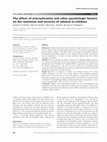
Pediatric allergy and immunology : official publication of the European Society of Pediatric Allergy and Immunology, Jun 4, 2016
Asthma prevalence in Latin America is high and continues to increase. There is evidence that the ... more Asthma prevalence in Latin America is high and continues to increase. There is evidence that the psychological characteristics of the child are associated with greater asthma morbidity. This paper aims to investigate the independent effect of internalizing/externalizing problems on two asthma/wheeze outcomes: (1) remission and (2) progression to severity on Latin American children with mild asthma symptoms at baseline. This was a prospective study in a cohort of 371 asthmatic children living in a poor urban area in Salvador, Brazil. The psychological characteristics of the child were assessed using the Child Behavior Checklist (CBCL) and wheezing was defined using the ISAAC questionnaire at the start and end of follow-up. A multiple logistic regression model with random effects was used to examine the association between the psychological components and both outcomes. Remission of symptoms of wheeze was observed amongst 229 (61.73%) children. Remission was 56% lower amongst children...
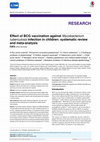
BMJ (Clinical research ed.), Jan 5, 2014
To determine whether BCG vaccination protects against Mycobacterium tuberculosis infection as ass... more To determine whether BCG vaccination protects against Mycobacterium tuberculosis infection as assessed by interferon γ release assays (IGRA) in children. Systematic review and meta-analysis. Searches of electronic databases 1950 to November 2013, checking of reference lists, hand searching of journals, and contact with experts. Community congregate settings and households. Vaccinated and unvaccinated children aged under 16 with known recent exposure to patients with pulmonary tuberculosis. Children were screened for infection with M tuberculosis with interferon γ release assays. Study results relating to diagnostic accuracy were extracted and risk estimates were combined with random effects meta-analysis. The primary analysis included 14 studies and 3855 participants. The estimated overall risk ratio was 0.81 (95% confidence interval 0.71 to 0.92), indicating a protective efficacy of 19% against infection among vaccinated children after exposure compared with unvaccinated children. ...
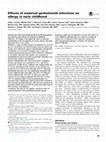
Journal of Allergy and Clinical Immunology, 2015
Background: Maternal geohelminth infections during pregnancy may protect against allergy developm... more Background: Maternal geohelminth infections during pregnancy may protect against allergy development in childhood. Objective: We sought to investigate the effect of maternal geohelminths on the development of eczema, wheeze, and atopy during the first 3 years of life. Methods: A cohort of 2404 neonates was followed to 3 years of age in a rural district in coastal Ecuador. Data on wheeze and eczema were collected by means of questionnaire and physical examination at 13, 24, and 36 months of age. Atopy was measured based on skin prick test (SPT) reactivity to 9 allergens at 36 months. Maternal stool samples were examined for geohelminths by microscopy. Data on potential confounders was collected after birth by questionnaire. Results: Geohelminths were observed in 45.9% of mothers. Eczema and wheeze were reported for 17.7% and 25.9%, respectively, of 2069 (86.1%) children with complete follow-up to 3 years, and allergen SPT reactivity to any allergen was present in 17.2% and to house dust mite in 8.7%. Maternal geohelminth infections were not significantly associated with eczema (adjusted odds ratio [OR], 1.26; 95% CI, 0.98-1.61), wheeze (adjusted OR, 1.02; 95% CI, 0.82-1.27), and SPT reactivity to any allergen (adjusted OR, 0.79; 95% CI, 0.61-1.01). In subgroup analyses maternal geohelminths were associated with a significantly reduced risk of SPT reactivity to mite and other perennial allergens, and maternal ascariasis was associated with an increased risk of eczema and reduced risk of SPT reactivity to all allergens. Conclusion: Our data do not support a protective effect of maternal infections with geohelminth parasites during pregnancy against the development of eczema and wheeze in early childhood, although there was evidence in subgroup analyses for a reduction in SPT reactivity to house dust mites and perennial allergens.
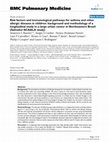
BMC pulmonary medicine, Jan 23, 2006
The prevalence of asthma and allergic diseases has increased in industrialised countries, and it ... more The prevalence of asthma and allergic diseases has increased in industrialised countries, and it is known that rates vary according whether the area is urban or rural and to socio-economic status. Surveys conducted in some urban settings in Latin America found high prevalence rates, only exceeded by the rates observed in industrialised English-speaking countries. It is likely that the marked changes in the environment, life style and living conditions in Latin America are responsible for these observations. The understanding of the epidemiological and immunological changes that underlie the increase in asthma and allergic diseases in Latin America aimed by SCAALA studies in Brazil and Ecuador will be crucial for the identification of novel preventive interventions. The Salvador-SCAALA project described here is a longitudinal study involving children aged 4-11 years living in the city of Salvador, Northeastern Brazil. Data on asthma and allergic diseases (rhinitis and eczema) and pot...
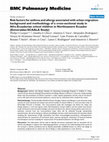
BMC pulmonary medicine, Jan 13, 2006
Asthma and allergic diseases are becoming increasingly frequent in children in urban centres of L... more Asthma and allergic diseases are becoming increasingly frequent in children in urban centres of Latin America although the prevalence of allergic disease is still low in rural areas. Understanding better why the prevalence of asthma is greater in urban migrant populations and the role of risk factors such as life style and environmental exposures, may be key to understand what is behind this trend. The Esmeraldas-SCAALA (Social Changes, Asthma and Allergy in Latin America) study consists of cross-sectional and nested case-control studies of school children in rural and urban areas of Esmeraldas Province in Ecuador. The cross-sectional study will investigate risk factors for atopy and allergic disease in rural and migrant urban Afro-Ecuadorian school children and the nested case-control study will examine environmental, biologic and social risk factors for asthma among asthma cases and non-asthmatic controls from the cross-sectional study. Data will be collected through standardised ...
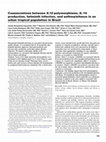
The Journal of allergy and clinical immunology, 2013
Helminth infections are associated with protection against allergies. It is postulated that IL-10... more Helminth infections are associated with protection against allergies. It is postulated that IL-10 production after helminth infection suppresses skin hypersensitivity and increases IgG₄ production, protecting against allergies. We aimed to determine whether IL10 polymorphisms are associated with helminth infection and the risk of wheeze and allergy. Twelve IL10 single nucleotide polymorphisms were genotyped in 1353 children aged 4 to 11 years living in a poor urban area in Salvador, Brazil. Wheezing status, Ascaris lumbricoides and Trichuris trichiura infection, IL-10 production by peripheral blood leukocytes stimulated with A lumbricoides extract, serum total IgE levels, specific IgE levels, skin prick test responses to common aeroallergens, and IgG4 and IgE anti-A lumbricoides antibody levels were measured in all children. Association tests were performed by using logistic or linear regression when appropriate, including sex, age, helminth infection, and principal components for a...
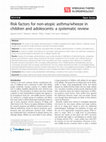
Emerging themes in epidemiology, 2014
The study of non-atopic asthma/wheeze in children separately from atopic asthma is relatively rec... more The study of non-atopic asthma/wheeze in children separately from atopic asthma is relatively recent. Studies have focused on single risk factors and had inconsistent findings. To review evidence on factors associated with non-atopic asthma/wheeze in children and adolescents. A review of studies of risk factors for non-atopic asthma/wheeze which had a non-asthmatic comparison group, and assessed atopy by skin-prick test or allergen-specific IgE. Studies of non-atopic asthma/wheeze used a wide diversity of definitions of asthma/wheeze, comparison groups and methods to assess atopy. Among 30 risk factors evaluated in the 43 studies only 3 (family history of asthma/rhinitis/eczema, dampness/mold in the household, and lower respiratory tract infections in childhood) showed consistent associations with non-atopic asthma/wheeze. No or limited period of breastfeeding was less consistently associated with non-atopic asthma/wheeze. The few studies examining the effects of overweight/obesity ...
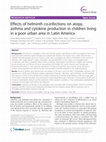
BMC research notes, Jan 19, 2014
Helminths are modulators of the host immune system, and infections with these parasites have been... more Helminths are modulators of the host immune system, and infections with these parasites have been associated with protection against allergies and autoimmune diseases. The human host is often infected with multiple helminth parasites and most studies to date have investigated the effects of helminths in the context of infections with single parasite or types of parasites (e.g. geohelminths). In this study, we investigated how co-infections with three nematodes affect markers of allergic inflammation and asthma in children. We selected Ascaris lumbricoides and Trichuris trichiura, two parasites that inhabit the human intestine and Toxocara spp (Toxocara canis and/or T. cati), intestinal roundworms of dogs and cats that cause systemic larval infection in humans. These parasites were selected as the most prevalent helminth parasites in our study population. 36.4% of children were infected with one parasite; 12.7% with 2 and 5.2% with 3. Eosinophilia>4% and >10% was present in 74....
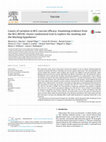
Vaccine, 2014
BCG protection varies and in some places (nearest the equator) is low or absent. Understanding th... more BCG protection varies and in some places (nearest the equator) is low or absent. Understanding this variation can inform the efforts to develop new vaccines against tuberculosis. Two main hypotheses are used to explain this variation: under masking, new vaccines are unlikely to increase protection; under blocking new vaccines have a greater potential to be effective when BCG is not. We conducted a cluster randomized trial to explored the masking and blocking hypotheses by studying BCG vaccine efficacy of neonatal vaccination and when administered for the first or a second (revaccination) time at school age in two sites (Manaus close and Salvador further south from the equator). Seven hundred and sixty three state schools were matched on socio economic characteristics of the neighborhood and 239,934 children were randomized to vaccine (BCG vaccination at school age) or control group. Protection by first BCG vaccination at school age was high in Salvador (34%, 95% CI 7-53%, p = 0.017) but low in Manaus (8%, 95% CI t 0 39-40%, p = 0.686). For revaccination at school age, protection was modest in Salvador (19%, 95% CI 3-33%, p = 0.022) and absent in Manaus (1%, 95% CI to 27-23%, p = 0.932). Vaccine efficacy for neonatal vaccination was similar in Salvador (40%, 95% CI 22-54%, p < 0.001) and Manaus (36%, 95% CI 11-53%, p = 0.008). Variation in BCG efficacy was marked when vaccine was given at school age but absent at birth, which points towards blocking as the dominant mechanism. New tuberculosis vaccines that overcome or by pass this blocking effect could confer protection in situations where BCG is not protective. The Department of International Development, UK (DFID) and the National Health Foundation, Brazil (FUNASA) funded the trial. It is registered at Controlled Trials (ISRCTN07601391).
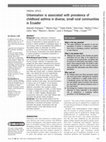
Thorax, 2011
Background Studies conducted in transitional communities from Africa and Asia have pointed to the... more Background Studies conducted in transitional communities from Africa and Asia have pointed to the process of urbanisation as being responsible for the increase in asthma prevalence in developing regions. In Latin America, there are few published data available on the potential impact of urbanisation on asthma prevalence. The aim of the present study was to explore how the process of urbanisation may explain differences in asthma prevalence in transitional communities in northeastern Ecuador. Methodology/principal findings An ecological study was conducted in 59 communities in Esmeraldas Province, Ecuador. Indicators of urbanisation were grouped into three indices representing the processes associated with urbanisation: socioeconomic, lifestyle and urban infrastructure. Categorical principal components analysis was used to generate scores for each index and a fourth indexda summary urbanisation indexdwas derived from the most representative variables in each of the three indices. The authors analysed the associations between community asthma prevalence and the indices, as well as with each indicator variable of every group. The overall prevalence of asthma was 10.1% (range 0e31.4% between communities). Three of the four indices presented significant associations with community asthma prevalence: socioeconomic (r¼0.295, p¼0.023), lifestyle (r¼0.342, p¼0.008) and summary urbanisation index (r¼0.355, p¼0.006). Variables reflecting better socioeconomic status and a more urban lifestyle were associated with greater asthma prevalence. Conclusions These data provide evidence that the prevalence of asthma increases with increasing levels of urbanisation in transitional communities, and factors associated with greater socioeconomic level and changes towards a more urban lifestyle may be particularly important.
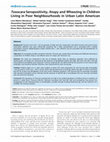
PLoS Neglected Tropical Diseases, 2012
Background: Toxocara canis and T. cati are parasites of dogs and cats, respectively, that infect ... more Background: Toxocara canis and T. cati are parasites of dogs and cats, respectively, that infect humans and cause human toxocariasis. Infection may cause asthma-like symptoms but is often asymptomatic and is associated with a marked eosinophilia. Previous epidemiological studies indicate that T. canis infection may be associated with the development of atopy and asthma. Objectives: To investigate possible associations between Toxocara spp. seropositivity and atopy and childhood wheezing in a population of children living in non-affluent areas of a large Latin American city. Methods: The study was conducted in the city of Salvador, Brazil. Data on wheezing symptoms were collected by questionnaire, and atopy was measured by the presence of aeroallergen-specific IgE (sIgE). Skin prick test (SPT), total IgE and peripheral eosinophilia were measured. Toxocara seropositivity was determined by the presence of anti-Toxocara IgG antibodies, and intestinal helminth infections were determined by stool microscopy. Findings: Children aged 4 to 11 years were studied, of whom 47% were seropositive for anti-Toxocara IgG; eosinophilia .4% occurred in 74.2% and .10% in 25.4%; 59.6% had elevated levels of total IgE; 36.8% had sIgE$0.70 kU/L and 30.4% had SPT for at least one aeroallergen; 22.4% had current wheezing symptoms. Anti-Toxocara IgG was positively associated with elevated eosinophils counts, total IgE and the presence of specific IgE to aeroallergens but was inversely associated with skin prick test reactivity. Conclusion: The prevalence of Toxocara seropositivity was high in the studied population of children living in conditions of poverty in urban Brazil. Toxocara infection, although associated with total IgE, sIgE and eosinophilia, may prevent the development of skin hypersensitivity to aeroallergens, possibly through increased polyclonal IgE and the induction of a modified Th2 immune reaction.
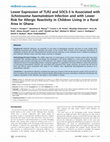
PLoS Neglected Tropical Diseases, 2008
Background: Helminth infections are prevalent in rural areas of developing countries and have in ... more Background: Helminth infections are prevalent in rural areas of developing countries and have in some studies been negatively associated with allergic disorders and atopy. In this context little is known of the molecular mechanisms of modulation involved. We have characterized the innate immune responses, at the molecular level, in children according to their helminth infection status and their atopic reactivity to allergens. Methodology/Principal Findings: The mRNA expression of several genes of the innate immune system that have been associated with microbial exposure and allergy was examined in 120 school children in a rural area in Ghana. Helminth infections were common and atopy rare in the study area. The analysis of gene expression in ex vivo whole blood samples reflected the levels of corresponding proteins. Using this approach in a population of school children in whom the presence of Schistosoma haematobium infection was associated with protection from atopic reactivity, we found that the level of TLR2 and SOCS-3, genes associated with atopy in the children, were significantly downregulated by presence of S. haematobium infection. Conclusions: S. haematobium infections modulate the expression of genes of the innate immune system (TLR2 and SOCS-3); these are genes that are associated with increased allergic inflammatory processes, providing a molecular link between the negative association of this infection and atopy in rural children in Ghana.
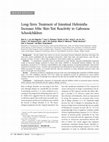
The Journal of Infectious Diseases, 2004
Background. Several studies have shown an inverse association between helminth infections and ato... more Background. Several studies have shown an inverse association between helminth infections and atopy, but none have clearly established that the pathogens themselves, rather than other associated factors, cause the suppression of atopy. To show a direct link, prospective intervention studies are required. Methods. A randomized, controlled trial was performed to study whether repeated anthelminthic treatment results in increased allergic sensitivity to house dust mites (HDMs) in chronically infected children. The trial population consisted of 317 Gabonese schoolchildren with a high prevalence of intestinal helminths. Intervention consisted of treatment every 3 months with praziquantel and mebendazole and with placebo in the control group. Follow-up lasted 30 months: at 6-month intervals, skin-test sensitivity to mites, helminth infection status, and levels of total IgE were determined. Results. Treatment resulted in a significant increase in the rate of developing skin sensitivity to HDMs (hazard ratio, 2.51; 95% confidence interval, 1.85-3.41), which was mediated, in part, by reductions in Ascaris and/or Trichuris infections. Levels of total IgE were reduced, but this did not mediate the effect of treatment on skin-test reactivity. Conclusions. Anthelminthic treatment of chronically infected children results in increased atopic reactivity, which indicates that helminths directly suppress allergic reactions. Rates of allergic disorders are increasing in the West, and, although allergies are considerably less prevalent in developing countries [1, 2], these conditions are increasing in the progressively urbanizing major cities [3, 4]. Studies have suggested that the reduced exposure to infectious agents that results from successful vaccination programs and the use of antibiotics may underlie the increase in allergic disorders [5, 6]. The immunological explanation for this "hygiene hypothesis" has
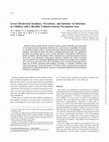
The Journal of Infectious Diseases, 2000
Bacillus Calmette-Guérin (BCG), the most common vaccine worldwide, has broad effects on the immun... more Bacillus Calmette-Guérin (BCG), the most common vaccine worldwide, has broad effects on the immune system. Hookworm infections are a major source of morbidity. In response to a preliminary report of BCG vaccination protection against nematodes in human immunodeficiency virus-infected adults, data from an ongoing prospective study were analyzed to determine the intensity (eggs per gram of stool), prevalence, and incidence of different helminths in children with and without a BCG vaccination scar. Adjusted prevalence and incidence ratios were estimated by using logistic regression. Children with a BCG vaccination scar were found to have statistically significantly lower hookworm prevalence (41%), incidence (37%), and mean egg counts (39%), after controlling for age, sex, and socioeconomic factors. There was no BCG association with incidence, prevalence, or intensity of infection with Schistosoma mansoni, Ascaris lumbricoides, or Trichuris trichiura. Such protection would have implications for public health and for research on mechanisms behind human immunological responses to hookworm.
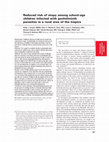
Journal of Allergy and Clinical Immunology, 2003
Background: Childhood infections might protect against the expression of atopy. Geohelminths are ... more Background: Childhood infections might protect against the expression of atopy. Geohelminths are among the most prevalent infections of childhood and might contribute to the low prevalence of allergic disease reported from rural areas of the tropics. Objective: We sought to establish whether geohelminth infections protect against atopy and to explore whether this protection is dependent on infection chronicity. Methods: The risk of atopy (measured by means of allergen skin test reactivity) associated with active geohelminth infections (measured by means of the presence of eggs in stool samples) or with chronic geohelminth infections (measured by means of high levels [≥3564 IU/mL] of total serum IgE or the presence of detectable anti-Ascaris lumbricoides IgG4 antibodies) was investigated in an analytic cross-sectional study conducted among school-age children attending rural schools in Pichincha Province in Ecuador. Results: A total of 2865 children aged 5 to 19 years from 55 schools was examined. Active infection with any geohelminth and infections with A lumbricoides or Ancylostoma duodenale were associated with significant protective effects against allergen skin test reactivity. Children with the highest levels of total IgE or with anti-A lumbricoides IgG4 antibodies were protected against skin test reactivity also, and the protective effects of high IgE or anti-A lumbricoides IgG4 and or active geohelminth infections were statistically independent. Conclusion: Active infections with geohelminth parasites and the presence of serologic markers of chronic infections (high levels of total serum IgE or anti-A lumbricoides IgG4) are independent protective factors against allergen skin test reactivity among school-age children living in an endemic region of the rural tropics. (
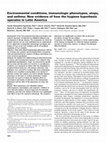
Journal of Allergy and Clinical Immunology, 2013
Background: It has been proposed that improved hygiene and reduced experience of infections in ch... more Background: It has been proposed that improved hygiene and reduced experience of infections in childhood influences the development of allergic diseases. The mechanisms by which the hygiene operates are not well established but are underpinned by two apparently incompatible immunologic paradigms, the balance of T H 1 versus T H 2 cytokines and IL-10-mediated regulation of T H 2 cytokines. Objective: This study defined immunologic phenotypes with the use of latent class analysis and investigated their associations with environmental factors, markers of allergy and asthma, in a Latin American population. Methods: We studied 1127 children living in urban Brazil. Data on wheeze and environmental exposures were collected with standardized questionnaires. Atopy was measured by specific IgE in serum and skin prick test reactivity to aeroallergens. Cytokines were measured in culture after the stimulation of peripheral blood leukocytes with mitogen. Infections with pathogens were assessed by serology and stool examinations. Children were classified as having high or low burden of infection. Latent class analysis was used to identify immune phenotypes on the basis of cytokine production. Logistic regression was used to evaluate the adjusted effects of environment and burden of infection on the immunologic phenotypes and the effect of the phenotypes on atopy and asthma. Results: Three phenotypes were identified, labeled underresponsive, intermediate, and responsive. Children of more educated mothers, living in improved environmental conditions, and with a low burden of infection were significantly more likely to have the responsive phenotype. The responsive phenotype was significantly associated with an increased prevalence of atopy but not asthma. Conclusion: Our findings contribute to a better understanding of the immune mechanisms by which the hygiene hypothesis operates in urban Latin America.
Pediatric allergy and immunology : official publication of the European Society of Pediatric Allergy and Immunology, 2011
Allergy is commoner in developed than in developing countries. Chronic worm infections show inver... more Allergy is commoner in developed than in developing countries. Chronic worm infections show inverse associations with allergy, and prenatal exposures may be critical to allergy risk.
Uploads
Papers by laura rodrigues